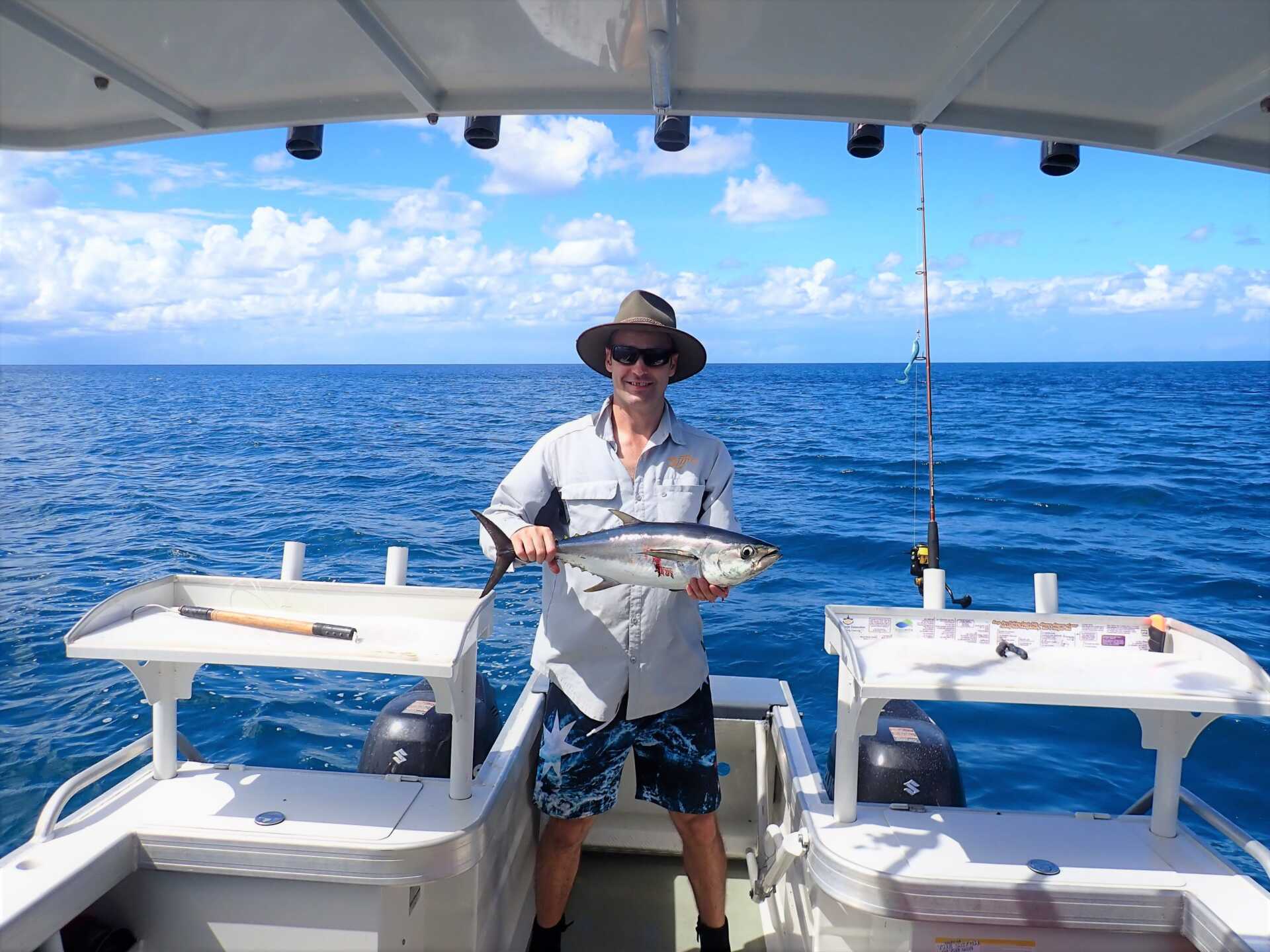Catching and smoking Longtail Tuna

As you know, OzFish is made up of different types of Rec Fishers and they’re all fishing in very different parts of Australia. One thing many have in common at the moment is the fact that they are hunting down a fish to make a decent meal at the end of the day. We got Geoff from Townsville to share with us the fishing he gets up to in the Far North Coast of Queensland.
Longtail tuna (Thunnus tonggol) are one of my favourite fish to catch on light gear. This species will be familiar to a large number of anglers in Queensland and they are popular enough to have their own Facebook page.
The sight of longtails smashing schools of baitfish on the surface and small flocks of terns following them around, hoping for an easy feed, is unmistakable. As anyone who chases them will know the surface action that gives their position away can be very fast, and their movements can be erratic. At they will reappear relatively quickly and within 1 km of their last sighted position, so with a half-decent boat you can follow them around, as long as you don’t go in too hard and spook them.
My most recent catch was in the waters around Hinchinbrook in north Queensland. The weather forecast was for light winds in the morning and then blowing up to >25 knots in the afternoon, so we spent most of the day motoring around the inshore waters. The aim was to target some of the demersal snappers, but just as we were about to set up on a spot, I spotted some surface activity out of the corner of my eye. Having the presence of mind to bring multiple set-ups on board, we threw the lures out the back and headed in their general direction for a trawl. Within minutes we had hooked one on the heavy gear, and we brought it on board reasonably quickly.

We tried trawling for a while longer but we weren’t having much luck, so we changed tactics and started casting at the surface activity. The first one of the day that I hooked gave me a lesson in having the drag set too tight. Using 20lb braid and 40lb mono, I overestimated the ability of my gear, tightened up the drag soon after hooking it and got promptly busted off. I geared up again, feeling extremely foolish for my rookie mistake and locked onto another at the next bit of surface action. I made sure to play this one appropriately and I had it landed and in the boat in ten minutes.
We chased them around for a couple of hours, often getting close enough that I could have casted a dry fly at them. I was having enough fun on the soft plastics so I decided to give the flies a miss.
We headed in after we managed to land four, all around about the 70cm mark.
Quick Facts: Longtail Tuna
Commonly found in tropical and sub-tropical waters of the Indo-west Pacific. In Australia, they can be found as far south as Twofold Bay in NSW and Cockburn Sound in WA.
They can grow to 1.36 m and 36 kg, but are more commonly caught in the 80-90 cm and 10-15 kg range.
Longtail Tuna seem to favour inshore waters and tend to congregate within the continental shelf, the fish we caught were all about 70 cm, making them 4 years old.
As with most fish, the possession and size limits differ between states:
- NSW, 5 fish <90cm and 2 fish >90 cm
- QLD, 20 fish total may be kept, no size limit
- NT, 15 fish total may be kept, no size limit
- WA, total of 3 large pelagic finfish per person, no size limit for longtail tuna
Conservation and threats
Longtail tuna are regarded as Least Concern by the International Union for the Conservation of Nature (IUCN), although NSW DPI have stated that there is insufficient data to determine the status of Longtail Tuna stocks in their waters. Knowledge gaps that hinder abilities to conduct adequate stock assessments include:
- Degree of connection between Australian stocks and those in Indonesia, Papua New Guinea and south-east Asia (commercial catches are much higher in south-east Asia than in Australian waters)
- Post-capture mortality (fish captured on light tackle tend to be exhausted once they are landed)
- Age-at-maturity (assumed to be ~4 years old)
- Annual catch and effort of the recreational sector (the recreational sector possibly has a greater impact on longtail tuna stocks in Australia than the commercial, but reliable catch and effort data for this fishery has been difficult to obtain)
Smoking

Longtail tuna are not highly regarded as a table fish, but I can’t say I’ve been disappointed with any I’ve prepared and eaten so far. They certainly don’t rank as highly in my esteem as, say, fresh coral trout, nannygai or mangrove jack, but when prepared well they can be extremely tasty. Fresh fillets can be cut into steaks and chucked straight in a hot pan with some butter and lemon juice, then served with some potatoes and green veg or salad.
Having access to a smoker, I decided to give that a crack this time around. It’s been a few years since I’ve smoked fish, but the basics haven’t changed for some time and recipes for cooking just about anything are a dime-a-dozen on the net. Without going into too much detail, my basic technique was:
- Cut fillets into steaks ½ – 1” thick and 6 – 8” long
- Prepare brine: 2 litres of water, ¼ cup of salt, ⅓ cup brown sugar (* there are loads of other things that can be added to the brine mix, but the base is usually similar to this)
- Pour the brine into a roasting tray, cover the fillets and leave in the fridge to soak overnight (* lots of recipes call for the brine to be added to zip lock bags, but it’s unnecessary if you have a roasting tray or other pan and ends up producing a heap of plastic waste)
- Remove fillets from brine, place on a grill-rack and leave to air dry for ~1 h before smoking
Imagine coming home to this after a day on the boat. - Just before smoking I basted each side of the fillets with olive oil, and sprinkled a pinch or two of cracked black pepper on the upper surface (* some recipes say you should pat the fillets dry with paper towel before smoking, others say you should wrap paper towel around the fillets overnight to draw out excess blood and moisture, others say you should place the fillets next to a fan after removing from the brine and allow a pellicle to form before smoking … as with all cooking, half the fun is experimenting and finding something that works well for you)
- Once the temperature in the smoker is at 80-85°C, add the fillets on the grill rack and smoke for between 2 and 4 h (time for smoking will depend on the thickness of the fillets, but you should aim for the internal temperature to be 60-65°C before removing)
- There are all sorts of ways that smoked fish can be served, but if prepared and smoked well it can be eaten by itself
Happy fishing and happy cooking.”
Further reading
Griffiths, S., et al., 2010, Biology, fisheries and status of longtail tuna (Thunnus tonggol), with special reference to recreational fisheries in Australian waters. Final Report: Fisheries Research and Development Corporation, Project Number 2008/058. pp. 107.

